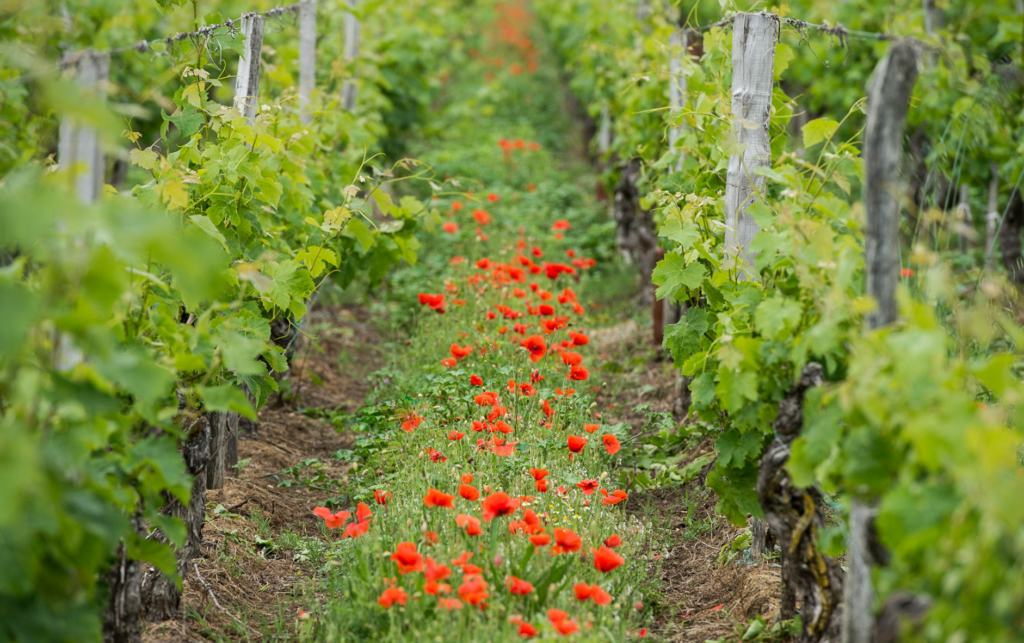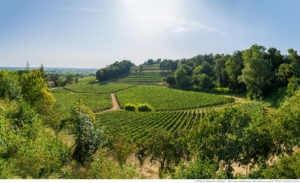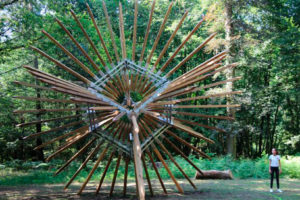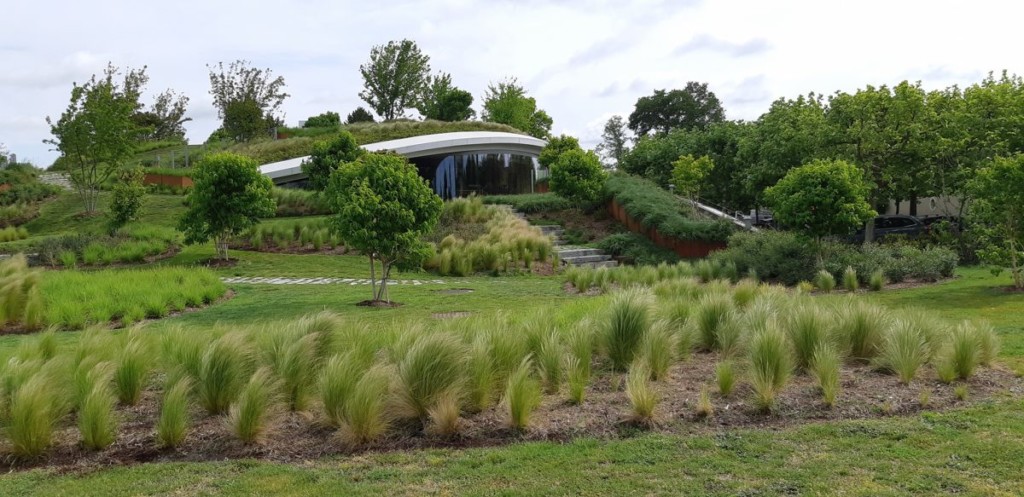The stability in Bordeaux wine quality is due in large part to stores of water in the sub soils from a wet winter, but could it also be that vines are starting to adapt to climate change parameters? What is sure is that wine makers are adapting their viticultural practices.
In recent vintages, Bordeaux has experienced a shorter vine growing cycle with earlier ripening and harvesting (approx. 20 days earlier over the past 30 years), an increase in hydric stress, changes in yield, alcohol, acidity and aromas in the finished wine. The proximity of the Atlantic ocean means producers here are used to managing some climate uncertainty, from spring frosts and seasonal hail to rain at flowering or harvest and hot summers.

Responses to these challenges include plot-by-plot precision viticulture with adapted canopy management, different planting densities, cover crops and increasing biodiversity through planting trees and hedgerows.
Recently Bordeaux has shown a proactive rather than reactive response to environmental challenges.
The CIVB (Conseil Interprofessional de Bordeaux or Bordeaux Wine Council) is investing €1.2m annually in on-going research by 200 researchers in over 20 public laboratories.
This is still experimental. Growers are limited to planting just 5% of their vineyards with these grape varieties and they must represent no more than 10% of the final blend for each colour.
Variety
Traditionally, AOC wines in Bordeaux were limited to six main red grape varieties and up to eight white grape varieties, already offering growers a catalogue of grape varieties with different growing cycles and ripeness spread over time. The six ‘new’ grape varieties include four red grape varieties: Arinarnoa, Castets, Marselan and Touriga Nacional and two white grape varieties: Alvarinho and Liliorila.
Blending is a useful tool for climate variability, allowing winemakers to diversify their blend to subtly mitigate the effects of climate change.
Sustainable
75% of the Bordeaux vineyards are under sustainable viticulture. This includes planting cover crops and agroforesty. The former increases bio diversity, keep a living soil that keeps humidity and create areas of cooler micro climates around trees and hedges.

Some properties include their woodland as part of the wine tourism offering. Château Bellefont Belcier (Best Of Wine Tourism Winner in 2023) offers a foot path that takes guests through their woods without ever leaving the property, Château Malartic Lagraviere includes the woods in their biodiversity visit.

In 2017, Château Smith Haut Lafitte created the Forest of the Five senses, a land art installation in eight hectares of woods on the property. This amazing experience was recognised by a Best Of Wine Tourism award that same year.
Prevention better than a cure?
Coping with the effects of climate change is important, but what practices are being put into place to help reduce or at least slow it down?
Stellar cellars
In 2010, Bordeaux was the first vineyard region to measure their carbon footprint. An online carbon footprint calculator allows each member to understand exactly where and how carbon economies can be made.
There’s no shortage of brand-new cellars in Bordeaux with architectural prowess combining functionality, beauty and the environmental impact, their carbon footprint, insulation and integration into the surroundings.
Carbon negative
The 10,000-m² renovation took every opportunity to save and to produce energy. They have a geothermal heating/cooling system for air conditioning in the barrel hall and fermentation vats and the 3,000 m² of rooftop solar panels generate enough electricity to meet most of the day-to-day needs of the buildings. They also produce bicarbonate from the CO2 produced during fermentation making the property carbon negative.
Biodynamic classified growth, Château Pontet Canet, also uses heat pumps and insulation to reduce energy consumption and solar panels to produce green energy. Château Chasse-Spleen in Moulis is self-sufficient in energy thanks to solar panels, and Château Lagrange installed 800m2 of solar panels in 2019 that now supply about 15% of power used at the winery.
Cru Bourgeois Château Paloumey in Haut Medoc has installed 400m2 of solar panels on the south facing roof of the tractor hangar, enough to be autonomous in energy. Château Smith Haut Lafitte has a stealth cellar carbon neutral and built in an old quarry with great insulation, including a vegetal roof
In 2016, Château d’Eyran built a unique eco-friendly cellar, clever insulation economizes energy thanks to locally made bio-bricks and light is maximized with floor to ceiling windows reducing electricity use. The wooden cladding, terracotta tiles and paint using natural pigments allow it to blend into and respect the environment.

At Chateau Haut Bailly in Pessac Léognan, environment and aesthetics go hand in hand. It took 100s of people working together for five years to create a stunning structure that perfectly integrates into the surroundings, is carbon neutral and has increased biodiversity thanks to a roof garden, purposely sown with plants to offer a mix of seeds and berries to support fauna.
All change.
Could it be that climate change is not all bad news? Appellations with cooler terroirs have traditionally struggled to get grapes to perfect ripeness every vintage. Perhaps climate change means it’s time to reassess our perception of some Bordeaux appellations?
Cornelis van Leeuwen, terroir expert at Bordeaux University thinks so. He has turned his attention to the satellite appellations of Saint Emilion, and in particular to Les Saints Elites, 8 family-owned vineyards working together since 2016 to promote these too often overlooked terroirs.
To the north of Saint Emilion, the appellations of Saint-Georges Saint-Emilion, Montagne Saint-Emilion, Puisseguin Saint-Emilion and Lussac Saint-Emilion have long been in the shadow of their more famous neighbour.
They have their terroir and their Merlot dominated blends in common with their more famous neighbour, although their wines were often characterised as ‘rustic’, cooler terroir showing green tannins in tricky vintages. No longer.
From handicap to advantage
In the hot, dry 2022 vintage, when top properties of Saint Emilion were given a last minute derogation to water vines, the satellites held up just fine. The vines produced wines with an elegant freshness that showed well in the recent primeur tastings.
These cooler conditions favour the aromatic expression of Merlot, a grape traditionally planted in the cooler soils across Bordeaux, but that quickly suffers from an excess of heat and with a short picking window.
This awareness of the advantage of cooler soils is not limited to the satellites. At a recent tasting in Château Grand Corbin, classified growth of Saint Emilion, enthusiastically shared that their location the northern, traditionally cooler, part of the Saint Emilion appellation was a plus. Not something they would have mentioned, let alone boasted about in the past. Fronsac, also had a great 2022 vintage. Traditionally a cooler neighbour of Saint Emilion, it neither had the right, nor the need to irrigate thanks to the cooler terroir with deep clay acting as a water reserve.
Could climate change be bringing Bordeaux’s cooler terroirs in from the cold?
Wendy Narby